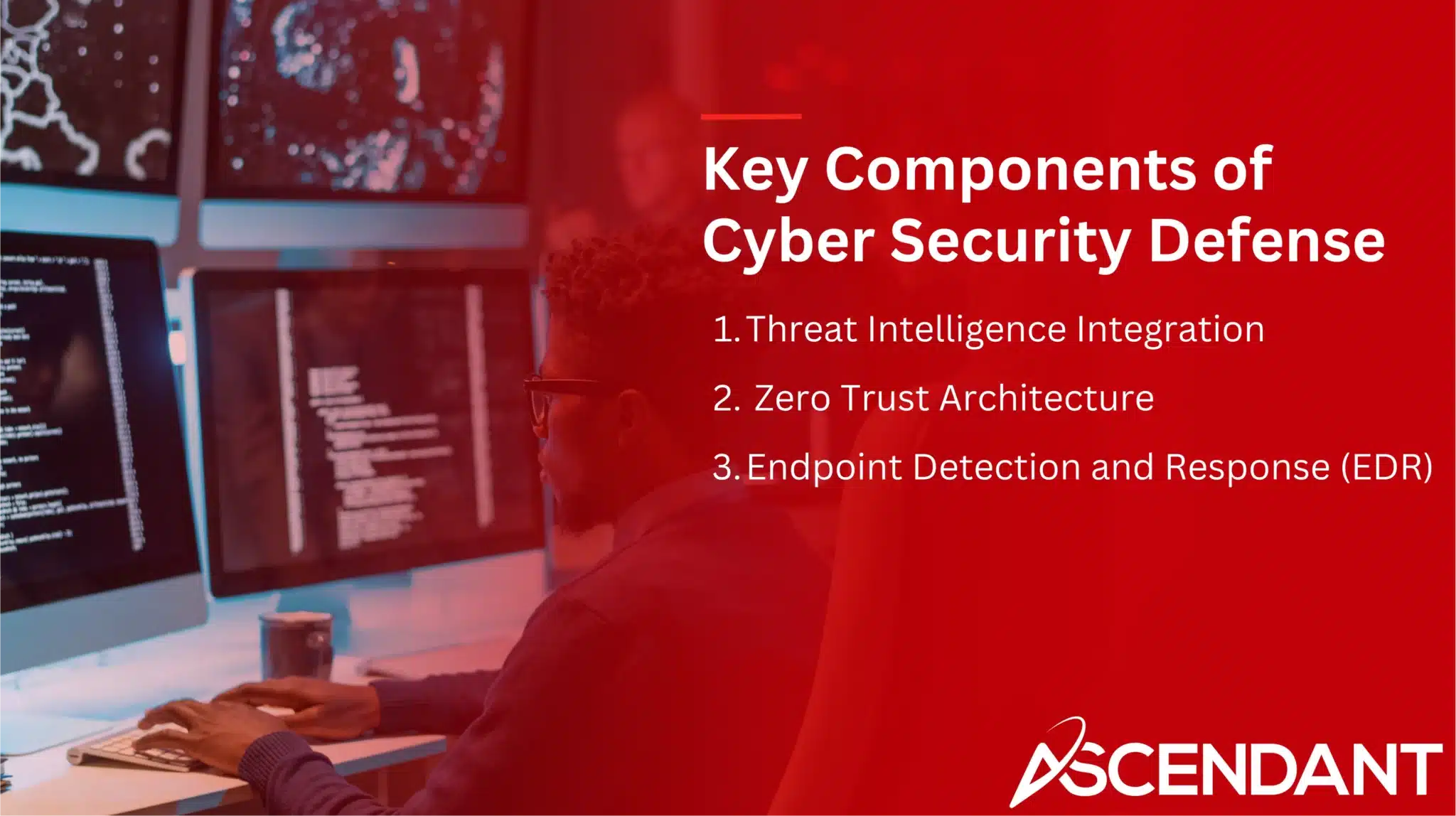Cyber security defense is vital for protecting against threats like malware and data breaches. This article explores strategies to enhance your defenses. Learn about key components, proactive measures, and real-world examples to build a strong cyber security defense system.
Key Takeaways
- Cybersecurity has evolved from basic tools to advanced measures like Zero Trust Architecture and Endpoint Detection and Response, necessitating continuous adaptation to complex threats.
- Integration of cybersecurity and cyber defense strategies is essential, with proactive measures aimed at preventing attacks and reactive tools focused on incident response.
- A resilient cyber defense system requires key components such as threat intelligence integration, incident response planning, and collaboration between public and private sectors to enhance security effectiveness.
The Evolution of Cyber Security Defense
In the early 21st century, widespread adoption of fundamental cybersecurity measures such as antivirus and firewall technology began to emerge. These essential tools served as primary barriers against cyber-attacks, providing crucial initial protection from online threats.
As we progressed into the mid-2000s, it became increasingly clear that more sophisticated security systems were required due to the growing complexity of cyber-attacks. Consequently, organizations implemented advanced intrusion detection systems (IDS) and reinforced network security protocols. The real-time identification and mitigation capabilities these provided allowed for a more adept response to cybersecurity incidents. During this period, regulatory requirements also started influencing how industries approached their cybersecurity practices by mandating stricter security controls.
With over two decades having passed since then, there has been considerable advancement in cybersecurity tactics owing to heightened awareness about potential risks and an uptick in threat sophistication. Technologies like commercial antivirus programs have matured alongside innovations including end-point detection strategies plus network detection and response methodologies—collectively forging stronger safeguards against various forms of cyber-attacks. This ongoing transformation emphasizes an imperative need. To continuously advance our defenses so that we can remain ahead of ever-evolving threats while maintaining a unified front for cyber defense.
The necessity for staying proactive amid escalating digital dangers is paramount. Hence adopting a comprehensive strategy becomes critical with increased frequency and severity of attack incidents observed today across multiple platforms within cyberspace. Entities must invest in cutting-edge protective solutions such as those offered by IronNet while keeping abreast with fresh developments shaping future paradigms aligned toward countering upcoming challenges collectively encourages this united stance on safeguarding assets digitally.
Understanding Cyber Security Defense vs. Cybersecurity
Effectively protecting against cyber threats requires understanding the distinction between cybersecurity education, cyber security, and cyber defense. Cybersecurity aims to prevent incidents through policies, controls, and best practices, focusing on identity management, data protection, and unauthorized access prevention.
Cyber defense, in contrast, focuses on detecting threats and minimizing damage during an attack. It assumes sophisticated adversaries will breach security measures, necessitating timely response and damage control. Although tools in cybersecurity and cyber defense vs cybersecurity can overlap, their deployment motivations differ—security tools are proactive while defense tools are reactive.
Cybersecurity encompasses a wide range of functions, including identity management and data protection, while cyber defense is more focused on threat intelligence and incident response. A strong cybersecurity foundation reduces unnecessary alarms for cyber defense, allowing it to focus on real threats. Investing in proactive security measures can help businesses avoid significant costs associated with data breaches.
Integrating cybersecurity and cyber defense strategies is vital for comprehensive protection. Proactive cybersecurity prevents attacks, while cyber defense quickly detects and mitigates breaches. Combining these approaches creates robust defense, helping organizations stay ahead of threats and maintain a unified front.
Key Components of Cyber Security Defense
Effective cyber security defense relies on several key components working together to protect against attacks. Implementing these components is vital for building a robust defense system. Three critical elements are Threat Intelligence Integration, Zero Trust Architecture, and Endpoint Detection and Response (EDR).
The Cyber Defense Matrix is a valuable tool that helps organizations navigate the cyber defense security landscape. It consists of the NIST Cybersecurity Framework functions and assets that need securing, providing a comprehensive view of the overall cyber defense strategy.
Understanding the Cyber Defense Matrix helps CISOs and security leaders enhance their strategies and ensure all critical areas are covered.
Threat Intelligence Integration
Enhancing your cyber defense with the integration of threat intelligence is an essential strategy for contemporary cybersecurity measures. By consolidating data from multiple sources, such as dark web surveillance and various threat feeds, these platforms offer a broad perspective on potential security risks. The insights gained are pivotal in fortifying firewall configurations, intrusion detection/prevention systems (IDS/IPS), and refining protocols for patch management.
By incorporating this intelligence into their framework, organizations can gain an upper hand against new and developing threats while bolstering their overall defensive stance. This forward-thinking approach empowers security teams to detect suspicious activity more efficiently and ensures that protective measures remain current.
To maintain robustness against increasingly sophisticated digital adversaries, it is critical to blend IronNet’s advanced solutions with comprehensive threat intelligence – a combination that serves to ironclad strengthen your cyber defense significantly.
Zero Trust Architecture
The Zero Trust Architecture adopts a rigorous security framework that operates on the presumption of potential threats originating from both within and external to the network. By partitioning the network into discrete segments, rigorously confirming user identities, and implementing stringent access controls, this model significantly diminishes the likelihood of unauthorized individuals gaining entry and ensures that sensitive information is accessible only to verified users.
Supportive key technologies integral to enforcing Zero Trust Architecture include multi-factor authentication (MFA), micro-segmentation of networks, as well as comprehensive Identity and Access Management systems. The deployment of robust authentication methods in tandem with strategic segmentation bolsters overall defense mechanisms against infiltration while also avoiding any unfounded sense of safety among stakeholders.
Incorporating Zero Trust principles has become an indispensable facet in contemporary cybersecurity strategies. It serves as a formidable shield protecting against an extensive array of cyber threats.
Endpoint Detection and Response (EDR)
EDR tools are critical in today’s landscape of cyber defense, as they provide continuous surveillance of endpoints to uncover abnormal actions that may signal impending threats. Through the observation of endpoint behaviors, EDR solutions facilitate immediate identification and reaction to potential dangers, enabling a more rapid response when dealing with cyber incidents.
Not only do these tools monitor activities on endpoints, but they also take action against identified threats. This functionality is vital for curtailing and lessening the effects of cyber attacks. By implementing EDR technologies, organizations can bolster their incident response strategies and fortify defenses against continuously changing cybersecurity challenges.
Proactive Cyber Security Defense Strategies
Staying on top of cyber threats necessitates the implementation of forward-thinking strategies. Companies that prioritize and allocate resources to cybersecurity measures tend to surpass their counterparts who neglect this critical area. Establishing a complex defense with various layers is crucial for maintaining an advantage over these evolving threats, securing thorough coverage.
To aid entities in addressing cyber risks effectively, the Cybersecurity and Infrastructure Security Agency (CISA) disseminates information about contemporary trends while fortifying protective systems. Maintaining awareness of up-to-date cybersecurity practices paired with taking preventive actions enables organizations to form a solidified front for cyber defense capable of staying ahead in the dynamic landscape of online dangers.
Deception Technology
Utilizing deception technology can effectively entice attackers while simultaneously safeguarding genuine assets. It employs strategies such as deploying honeypots, which are decoy systems designed to lure in malicious cyber actors. Observing how attackers operate within a secure setting provides enterprises with critical understanding regarding the methods and strategies employed by cyber criminals.
Leveraging the insights obtained from this surveillance, organizations can bolster their defensive mechanisms and refine their incident response prowess. Deception technology offers an assertive strategy for cyber defense that empowers entities to maintain an advantage over emerging cyber threats and fortify their comprehensive security stance.
Cloud Security Posture Management (CSPM) Tools
Tools for managing cloud security posture, known as CSPM tools, play an essential role in detecting potential misconfigurations and vulnerabilities within cloud infrastructures before they become targets of exploitation. By perpetually scanning these environments, CSPM ensures adherence to industry standards and the maintenance of a secure state. Such proactive measures are vital in diminishing the likelihood of succumbing to cyber attacks.
For example, SingularityTM Cloud Security delivers instantaneous protection across public, private, and hybrid cloud settings by addressing configuration errors that could leave systems vulnerable. The implementation of such tools fortifies cyber defenses against current risks while simultaneously offering strategies to stay ahead amidst constantly transforming threats.
Managed Detection and Response (MDR)
Managed Detection and Response (MDR) services bolster an organization’s security posture by delivering expert analysis alongside persistent surveillance, which sharpens the capacity to pinpoint threats with higher accuracy. These services deliver a robust suite of capabilities for threat detection and response, assuring that enterprises can swiftly manage cyber incidents. MDR is especially beneficial for entities lacking specialized in-house cybersecurity proficiency.
A principal role of MDR encompasses advanced threat hunting activities aimed at uncovering concealed risks and menaces. By tapping into the knowledge pool of MDR providers, organizations enhance their incident response skills while ensuring that their defenses remain current.
As an integral element within any forward-thinking cyber defense approach, Managed Detection and Response equips businesses with the necessary tools to preemptively confront cyber threats.
Building a Resilient Cyber Security Defense System
Creating a robust cyber defense system necessitates an all-encompassing strategy that incorporates defensive measures, ongoing evaluations, and incessant enhancement. A well-formulated defensive approach improves the speed of recovery and assists in averting threats, guaranteeing swift restoration following any incursions.
It is crucial for entities to scrutinize their existing security stance meticulously and pinpoint shortcomings in order to bolster their overall defenses. By adopting a forward-thinking mindset and integrating strong protection systems, organizations can safeguard their IT infrastructure while diminishing potential hazards.
As an instrumental resource for constructing stalwart cyber defenses, the NIST Cybersecurity Framework delineates five fundamental operational functions: Identify, Protect, Detect Respond, and Recover. This framework serves as a critical guideline for those seeking to develop resilient information security protocols.
Core Principles
Fundamental tenets that bolster cyber defense consist of:
- Encrypting data, safeguarding sensitive information from unsanctioned access and maintaining its confidentiality
- Employing redundancy to preserve the availability and integrity of data through the use of duplicate systems
- Formulating a disaster recovery strategy with routine backups is essential in reinforcing your cyber defense.
Adhering to these fundamentals secures data while facilitating uninterrupted business operations.
An all-encompassing disaster recovery plan should incorporate strategies for backup and restoration as an effective means to address cyber incidents. Such a plan ensures that entities can swiftly recuperate from cyber-attacks, thereby curtailing operational disruptions. Concentrating on these elemental principles allows organizations to cultivate a robust system for cyber defense capable of guarding against an array of cyberspace threats.
Incident Response Planning
Having an incident response plan is essential for the rapid identification, containment, and remediation of cyber-attacks. It’s vital that this strategy effectively minimizes interruptions when a cyber incident occurs by detailing actions to be executed during such events, thereby clarifying duties and roles for every team member involved.
Regular exercises are important to confirm the robustness of these plans against contemporary threats. To manage cyber incidents adeptly, establishing a governance structure tailored to cybersecurity is indispensable.
Strengthening your capacity for cyber defense hinges on having a well-conceived incident response blueprint in place that guarantees prompt and effective countermeasures against cyber assaults.
Leveraging AI and Machine Learning
The implementation of AI technologies plays a crucial role in improving the speed at which cybersecurity systems detect and respond to threats. Utilizing machine learning, these systems can sift through enormous datasets to identify potential security infractions swiftly. By adopting both AI and machine learning, entities are equipped to stay ahead of evolving cyber threats while bolstering their overall defensive stance.
IronNet’s IronDome exemplifies this by employing analytics paired with machine learning, offering insights into otherwise unnoticed dangers for organizations working solo. This innovation enriches detection and response by integrating behavioral analytics within existing security frameworks.
Incorporating AI along with machine learning cultivates a robust cyber defense mechanism that excels in recognizing and managing threats instantly, ensuring real-time protection against complex vulnerabilities.
Real-world Examples of Effective Cyber Security Defense
Case studies such as those of Maersk and Quantiphi offer valuable lessons in cyber defense by demonstrating how companies have overcome specific security obstacles. By examining these instances, other organizations can develop and improve their own strategies for cyber security.
The way Maersk rebounded from the NotPetya incident, alongside Quantiphi’s adoption of SentinelOne’s artificial intelligence-driven tools, serve as exemplary models of successful cyber defense tactics. These examples underscore the significance of having a solid defensive approach in place and highlight the advantages that come with integrating cutting-edge technologies to bolster cybersecurity measures.
Maersk’s Recovery from NotPetya
In 2017, the NotPetya malware strike severely disrupted Maersk’s operational capabilities, causing widespread system outages and preventing access to essential applications. The cyber attack resulted in the destruction of online backups, impacted close to 50,000 laptops and took down their VoIP network. Maersk chose to reconstruct its systems from the ground up rather than trying to recover corrupted data by relying on an offline physical copy of its Active Directory that survived the attack.
Recovery efforts spanned approximately 70 days. Fundamental operations were resumed by day ten after two weeks. Following this incident with NotPetya, Maersk revamped its cybersecurity measures and implemented a more fortified backup infrastructure designed to better resist potential future attacks.
The ordeal highlighted how critical it is for organizations to have strong recovery strategies and resilient infrastructures in place as a defense against detrimental effects caused by cyber attacks.
Quantiphi’s Use of SentinelOne
Quantiphi employs the AI-powered threat mitigation functions of SentinelOne to fortify its data protection strategy. This approach intensifies data security by delivering prompt responses to threats and reducing the consequences of cyber attacks. The intelligent policy management, asset monitoring, and forensic analysis tools from SentinelOne Consolidate Quantiphi’s defenses against cyber incursions.
By integrating SentinelOne’s AI-fueled solutions into their systems, Quantiphi refines its processes for addressing threats while safeguarding data integrity. This scenario exemplifies how adopting cutting-edge technology bolsters cybersecurity measures in anticipation of continually changing threats.
Collaborating for Stronger Cyber Security Defense
Working together, IT and security teams can significantly bolster cyber defense capabilities. Following the NotPetya incident, Maersk implemented a strategy that encourages cooperation and open communication between its IT and security departments. This strategy has led to enhanced threat detection speed and improved information dissemination. Such teamwork greatly enhances the potency of strategies designed to protect against cyber threats.
By cultivating an environment where collaboration is paramount, organizations facilitate swift sharing of critical information, accelerate the identification of potential threats, and boost their incident response effectiveness. Establishing this synergistic culture presents a unified front for cyber defense that markedly improves an organization’s security stance.
Public and Private Sector Collaboration
Establishing a robust cyber defense is fundamentally anchored in the trust and synergy between the public and private sectors. Since businesses control much of our essential infrastructure, their cooperation is indispensable for fortifying collective cyber resilience. These partnerships bolster quick exchanges of vital threat intelligence and strategies to counteract risks.
Cultivating collaboration across different sectors results in a unified front for cyber defense, reinforcing the security stance at large. Sharing information mutually among public and private entities is crucial for boosting cybersecurity measures and safeguarding critical infrastructures against threats.
IronNet’s IronDome
IronDome enhances the collective cyber defense by fostering real-time information sharing about cyber threats among various organizations. This platform promotes a cohesive defensive strategy by linking different parties, thereby elevating their overall understanding of the threat landscape. By offering insights into communal cyber threats through visual data representations, IronDome assists security teams in identifying and tackling immediate dangers more effectively.
Through IronNet’s IronDome collaboration is encouraged across distinct sectors to amplify joint defenses against digital menaces. The use of this tool allows for an increase in situational awareness amongst participants, facilitating a fortified response mechanism to counteract cybersecurity challenges efficiently.
Summary
The development of cyber defense has been characterized by a relentless pursuit of innovation and adaptability. The arsenal against cyber threats has expanded from simple antivirus programs and firewall barriers to sophisticated threat detection systems and the implementation of zero trust frameworks, all in an effort to counter increasingly complex threats. Recognizing the nuances that differentiate cybersecurity from cyber defense is pivotal for crafting an encompassing defensive strategy.
For a fortified stance against digital dangers, essential elements such as integration of Threat Intelligence, employing Zero Trust Architectures, and implementing Endpoint Detection and Response play critical roles. Forward-leaning tactics like Deception Technology along with Cloud Security Posture Management (CSPM) tools complemented by Managed Detection and Response (MDR) offerings are indispensable for organizations aiming to preventively tackle cyber threats while maintaining a unified front for effective cyber protection.
Fostering teamwork among IT experts and security squads—alongside fostering synergies between entities in both public service realms as well as within industry circles—is imperative when reinforcing overall defenses against virtual hazards. Illustrative case studies such as Maersk’s bounce back post-NotPetya attack or Quantiphi’s deployment of SentinelOne provide instructive examples underscoring successful strategies in facing off against potential breaches. Keeping abreast with emerging trends while integrating cutting-edge technology equips enterprises with resilient infrastructures capable of thwarting dynamic online challenges.
Frequently Asked Questions
What is the difference between cyber security and cyber defense?
Cyber defense focuses on identifying threats and mitigating damage during assaults, while cybersecurity is about creating protocols and measures to avert incidents.
How has cyber security defense evolved over the years?
Cyber security defense has significantly advanced from simple antivirus software and firewalls to sophisticated solutions like intrusion detection systems and zero trust architectures. This evolution reflects the growing complexity of cyber threats and the need for more robust security measures.
What are the key components of an effective cyber security defense system?
An effective cyber security defense system must incorporate Threat Intelligence Integration, Zero Trust Architecture, and Endpoint Detection and Response (EDR). These components collaboratively strengthen protection against cyber attacks and improve the overall security posture.
How can organizations stay ahead of evolving cyber threats?
Organizations must adopt proactive measures such as Deception Technology, Cloud Security Posture Management (CSPM) tools, and Managed Detection and Response (MDR) services to stay ahead of the constantly evolving cyber threats.
By utilizing these strategies, organizations can identify and react to potential dangers before they result in substantial damage.
Why is collaboration important for cyber security defense?
Working together is critical for cybersecurity defense because it promotes better sharing of information, enhances the ability to detect threats, and solidifies incident response capabilities.
This cooperation across different sectors greatly reinforces the overarching security stance.




